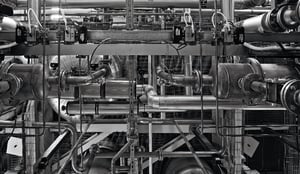Embodied carbon, refers to the carbon emissions associated with the production and transportation of materials used to make a product.
As the world becomes more aware of the dangers of climate change, many businesses are beginning to look for ways to reduce their carbon footprint. While much of the focus has been on reducing operational emissions, there is another aspect of a business’s carbon footprint that is often overlooked: embodied carbon.
What is embodied carbon?
Embodied carbon (sometimes incorrectly referred to as embedded carbon), refers to the carbon emissions associated with the production and transportation of materials used to make a product, along with the manufacturing process itself. In the construction of buildings and infrastructure, embodied carbon is the carbon footprint from cradle to gate, which is A1 to A3 of the whole life cycle carbon assessment (WLCA).

Why is embodied carbon important?
Embodied carbon is important because it represents a significant proportion of a product’s lifetime emissions. In fact, for many materials, the embodied carbon can be greater than the operational carbon emissions over the lifetime of the product. For example, a building’s structure may have a carbon footprint of 60% embodied carbon and 40% operational carbon. Include the replacement of a product within the full lifetime of the products parent system, the embodied carbon can be as high as 90% of the total GHG emissions.
How can embodied carbon be reduced?
Reducing embodied carbon can be a complex process, as it involves considering and measuring the emissions from multiple aspects of the production journey. However, there are several steps that businesses can take to reduce their embodied carbon:
- Follow the Carbon Hierarchy from high priority to low – Avoid, Reduce, Replace, Compensate, Remove.
- Choose low-carbon materials: Select materials with a low embodied carbon, such as recycled materials or sustainable alternatives.
- Reduce waste: Minimise waste during the manufacturing process, as waste materials contribute to embodied carbon.
- Optimise transportation: Transport products and materials efficiently, such as using low-emission vehicles or sourcing locally.
- Design for deconstruction: Design products and buildings so they can be easily disassembled and reused, reducing the need for new materials.
- Measure and track: Measure and track embodied carbon, so progress can be monitored, and improvements can be made over time.
It is not always easy for many businesses, we understand that this can be more difficult in other cases where complex materials/methods are used. Therefore, when calculating the embodied carbon of your product, it is always advisable to consult an expert.
Why should businesses focus on reducing embodied carbon?
By reducing embodied carbon, businesses can lower their overall carbon footprint, which in turn can help to reduce the impact of climate change. Additionally, reducing embodied carbon can also have financial benefits, such as reducing material costs and improving brand reputation.
Reducing embodied carbon will give your company a competitive advantage over rivals. Calculating the emissions from a product that is purchased by clients is hugely important for businesses submitting their carbon footprint every year. From potential clients point of view, knowing the exact value for emissions for purchased goods is a huge advantage as it redacts the need for the unreliable spend based method when calculating a business’s total carbon footprint. Reducing this embodied carbon shall reduce your clients’ emissions from Scope 3, Category 1, Purchased Goods and Services.
While reducing operational carbon emissions is important, it is equally important for businesses to consider the embodied carbon of their products and materials. By taking steps to reduce embodied carbon, businesses can not only reduce their impact on the environment, but also improve their bottom line. Our team of scientists are proven experts in reducing embodied carbon for businesses, if you are looking for help in figuring out your product’s embodied carbon, don’t hesitate to get in touch!



